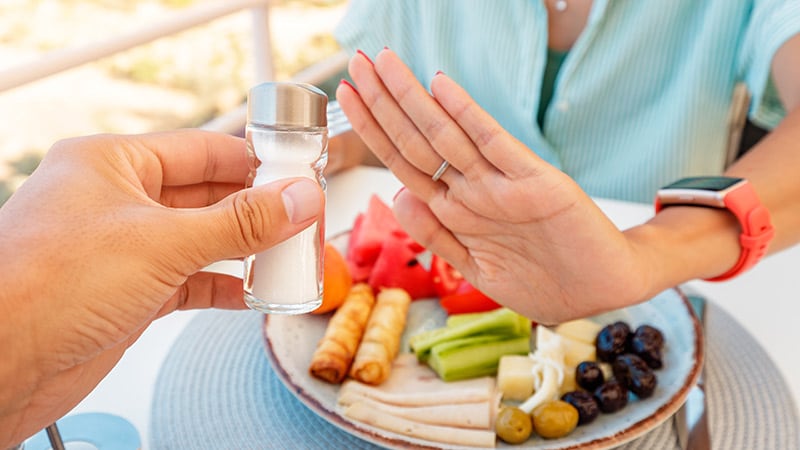Using a salt meter or sensor in food itself, in conjunction with other measures, can help reduce sodium intake by improving control of arterial hypertension at the community level, according to a Thai study. The results were described at the World Congress of Nephrology.
“It is very important for people to reduce salt intake,” Surasak Kantachuvesiri, MD, PhD, associate professor of nephrology at the Faculty of Medicine Ramathibodi Hospital, Mahidol University, in Bangkok, Thailand, told the Medscape Spanish edition. “The meter is easy to use, it controls the concentration in food, and allows the person to gradually, over weeks and months, become accustomed to meals with less sodium and not return to saltier ones.”
The salt meter tested in the study is immersed in liquid solutions and displays the degree of salt concentration in seconds through a smiling, surprised, or frowning face. It could be particularly appropriate for diets in Asian countries, where more than 60% of excess sodium comes from soups, sauces, and broths prepared at home.
However, “it could also be useful in Western countries because many people consume soups,” said Kantachuvesiri. Additionally, available meters can analyze salt concentration in solid foods, although they require prior dilution in water.
“What we propose is simply [to use that tool to] train taste buds to prefer foods with less salt,” he said.
Blood Pressure Reduction
In a 2021 randomized study involving 90 participants with arterial hypertension, Kantachuvesiri and his colleagues found that adding the salt meter to dietary education significantly reduced systolic and diastolic blood pressure and urinary sodium excretion after 8 weeks. It also increased sensitivity or the ability to detect sodium in foods.
In the current study, a randomized controlled cluster clinical trial, researchers recruited 219 participants aged 18-70 years with arterial hypertension (systolic blood pressure ≥ 130 mmHg) in six districts of the Thai province of Uthai Thani. Of that population, 111 (mean age, 60.03 years; 81.1% women) received a package of interventions consisting of education on the risk of excessive sodium intake, recommendations and recipes for preparing low-sodium foods, encouragement to community food vendors to offer low-sodium menus, and provision of a salt meter to monitor their consumption at least three times a week. Another 108 participants (mean age, 60 years; 72.2% women) served as the control group and received standard education.
There were no significant differences between the two groups in sociodemographic or morphological variables, such as education level, occupation, weight, or waist circumference. Nor did the groups differ in the median baseline systolic and diastolic blood pressures nor in the median urinary sodium excretion. There was a slightly higher proportion of patients with diabetes and dyslipidemia in the intervention group than in the control group (33.3% vs 25.9% and 64.0 vs 60.2%, respectively).
After 12 weeks, urinary sodium excretion was reduced by 525 mg/d (P = .004) among participants in the intervention group and by 299 mg/d (P = .267) among those in the control group. The difference in effects between the two groups was not statistically significant (P = .194).
There was also a greater reduction in systolic blood pressure (−13.51 mmHg vs −9.52 mmHg; P = .030) and a nonsignificant trend toward a decrease in diastolic blood pressure. Likewise, participants showed improved attitude and behavior in terms of consuming low-sodium foods.
“The comprehensive approach [including the use of the salt meter] could result in improvements in health literacy and less preference for salty foods, leading to effective control of sodium intake and blood pressure in the community. However, further studies in different populations are needed to evaluate long-term effects,” said Kantachuvesiri, who is part of the leadership team of the multidisciplinary Thai Low Salt Network, which was established in 2012 to promote sodium reduction.
Concerns About Practicality
The session’s moderator Gerardo Gamba Ayala, MD, a nephrologist at the Institute of Biomedical Research of the National Autonomous University of Mexico and director of research at the National Institute of Medical Sciences and Nutrition “Salvador Zubirán” in Mexico City, Mexico, expressed skepticism regarding the possibilities of using salt meters in Latin America.
“It is very difficult in people’s daily lives to be measuring the sodium content of meals, especially with solid foods,” he told Medscape Spanish edition.
The specialist considered it more feasible from the perspective of public policy to promote increasing the potassium chloride content in salt poured from saltshakers. “It cannot be done on such a widespread level as with iodized salt for goiter because the population with a certain degree of kidney disease is at greater risk of hyperkalemia, which would endanger their lives. But it would be convenient for most of the population from an early age to have higher potassium intake, since this would delay the development of arterial hypertension,” he stated.
Kantachuvesiri and Gamba reported having no relevant financial conflicts of interest.
This story was translated from the Medscape Spanish edition using several editorial tools, including AI, as part of the process. Human editors reviewed this content before publication.
